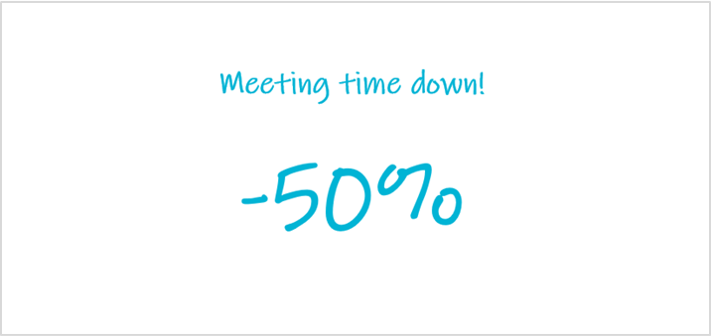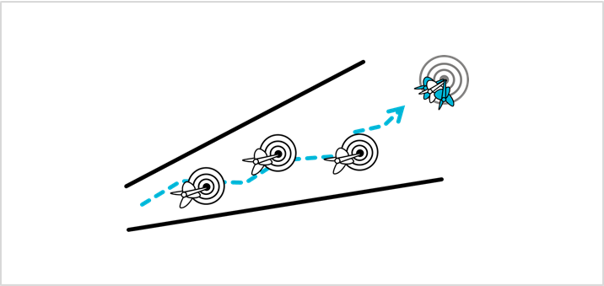
Case: Inspiring Managerial Strategy Meeting — 2.13
Markus Westerlund
Share this blog
I had an amazing experience at a managerial strategy meeting! It was new and exciting!
A different type of managerial strategy meeting

This meeting was different in some way. The dynamic was different with 47 managers from different nationalities, something I’ve never experienced before. We took a risk and gave only two-minute-long presentations each. Only two minutes per presentation, can you believe it?! The meeting also included five group assignments. A three-hour meeting which included two five-minute breaks every hour, five group assignments, and almost 20 presentations!
Quarterly strategy update

Firstly, this was about making a quarterly update to the strategy. This company’s strategy process has become agile. A large strategy process takes place once every 3 – 5 years, during which no stone is left unturned. After that, the strategy is updated quarterly with flexibility. Goals and subgoals are updated as the situation changes. The leaders, along with their groups, prepare the goals for the next quarter. Now was the time for a quarterly check-up for the managers, in which the goals for different individuals were laid out and discussed. This was a completely different kind of meeting where issues were summarized, and it involved people on a large scale.
Strategy update

The CEO welcomed everyone and told us about the goal of the day. A one-page strategy, the Strategy 1Pager, was in use. It had been modified with a few minor changes. It included an elevator pitch, which was the new thing. The elevator pitch means that the core idea is condensed into a couple sentences – a true high-level strategy crystallization, which effectively summarizes the strategy down to the core points. In case someone asks anyone involved about the company’s strategy, they better have an answer! The elevator pitch helps out in this situation.
By the way, profitable growth or growth aren’t strategies, they’re strategy types. When profitable growth is wanted, the strategy answers HOW the growth is created.
Commenting in groups

At the start of the managerial strategy meeting, the CEO spoke for about 15 minutes. The great thing was that people got to comment on the presented elevator speech in groups. The group work only took five minutes. A few improving ideas were commented, but all comments were mostly very exciting and clear!
Market situation

The next phase included presentations from three Business Unit leaders.
I told everyone that they had two minutes to explain what’s going on in the market. That simply hasn’t been done before! They had one slide prepared, much like the one above. As they spoke, I took notes and wrote them under the slide. I took time with my watch and let them know when they had 15 seconds left of their time. They spoke a couple of seconds over their time, but this system worked beautifully!
The next BU leader held their speech. So did the third one. And all of a sudden, we had listened to everything we needed to know about the market situation – in just 6 minutes! These three BU leaders were very good speakers, it was a pleasure to listen to them.
After that, everyone was allowed to speak in groups of three for five minutes. The groups consisted of different nationalities.
Group assignment: What inspires you?

People were divided into breakout rooms to answer the question: What is exciting about the market situation? You see, one doesn’t always have to talk about the market situation as a threat. Everyone wrote their comments on a digital platform. Here were some of the comments we received:
“There is a clear movement happening in the market! Trend is your friend!”
“The customers are there and the demand.”
“Being one of first movers is always inspiring. Many interesting opportunities.”
“We are right there where the growth is! That is motivating.”
“Our offer is right and reflecting the customer’s demand of more sustainable products.”
We received comments from each group, 15 altogether! We picked a few of them to discuss in a larger group. It’s so handy to divide people into breakout rooms and then back again, with just a touch of a button. We utilized Microsoft Teams for this.
Quarter goals

The next exercise was about presenting the quarterly goals. The Business Unit leaders once again had two minutes to talk about their quarterly goals. I had an image, which depicted the strategic goals, yearly goals, the previous quarter goals. Now was the time to present the next quarter’s goals.
After that came the next units: Marketing, HR, communications, financing, a lawyer, and several others gave their presentations. 12 presentations, two minutes at a time! Beforehand I had thought by myself what this all will amount to. The end result ended up being amazing!
Group assignment: How does it seem?

The whole group of managers now understood the supporting functions and their goals! Very often they are left forgotten. Again, people were divided into groups and asked how everything seemed like.
“Transparent, clear, and focused!”
“Quarterly solid goals that will be valid and important also in long term perspective!”
“Goals seem focused and ambitious. Need to ensure we are both ambitious and realistic in terms of timeline to achieve. – This comment shows, that it had power!”
“Not easy to evaluate all the goals, but increases the understanding what the others are doing. Many things going on. – A small moment, and suddenly it created full transparency!”
“Good to see support functions task/goals! This needs to be seen by the whole organization. Overall goals seem good and leading to success (long/short term)”
It was, of course, a risk to give two-minute presentations, but it got a round of applauds!
Key figures

Now it was time for the CEO to explain the numbers and volumes. Volumes had been good, but profitability needed improvement.

The next group assignment was to answer a tougher question: Where to find the big levers? A lever is my favorite metaphor. All activities are levers. There are small, medium, and large levers. Everyone got to identify the biggest things in their opinion.
Customer orientation was a topic that stood out from the comments. The customer is always at the front of the strategy. Comments were also given about internal meetings. People wished for fewer and shorter meetings. Work should be done together, with digital technology! Business processes and automation come into the picture even more strongly. Pretty cool!
We also discussed how it would be possible to do less. Where would time be of use? These issues were discussed once again in groups.
New IT boss

Next up was the IT manager’s introduction. They had together with their group begun a process, where the TOP3 key strategic questions for IT were contemplated.
The first question was: How can IT support us to grow our business as efficiently as possible? – Answers were given on a scale according to relevancy.
The last question got the least points: How could we get rid of overlapping systems? – Organizations have a number of systems, some of which overlap each other.
If and when a new business acquisition is made, new systems are often included in the deal. The image above shows that cleanup got the least points, that’s fine. However, profitability requires cleanup. Here are some comments we gathered during a short five-minute group assignment:
“Relevant topics, just continue with those targets.”
“To have a good helicopter view of the IT ecosystem. Make sure that people use the same systems.”
“IT works well.”
“More coordinated view on IT-needs and priorities.”
Wrap-up: How was the strategy meeting?

Finally, we asked people to give pulse comments about the managerial strategy meeting. The image below speaks for itself!
Usually, someone says that the speed was too fast. At the beginning of the meeting, I said to everyone that it is what it is. We need to get more done in less time! – Welcome to the new normal!
I was however surprised there was no critique. The idea of a managerial strategy meeting with two-minute presentations and discussions was a hit! It was also fun that people changed groups every time. Many got to meet new colleagues they hadn’t even talked to before.
Taking advantage of technology is the trick! Utilize it!
If you’re interested in this topic, let’s make a similar process with your group! I claim, that this really can change a company’s culture as one sees the opportunities to work with a larger group. If you hit the nerve, the management level, with agile work policies, things will begin to happen!
Ignite your strategy! Read more.🔥
Recent Posts
Stradigo
Stradigo is a brand owned by Rdigo Oy (Business-ID: 2120844-1).
Learn more from our Imprint.
Rdigo Oy is registered in Finland as a Limited company. We are a strategy consultancy located in the Helsinki capital region.
We’ve been in business since 2007. The company name comes from the latin word Redigo, meaning both ‘I shape’ & ‘I renew’.
Stradigo combines the word strategy with Rdigo.






























































